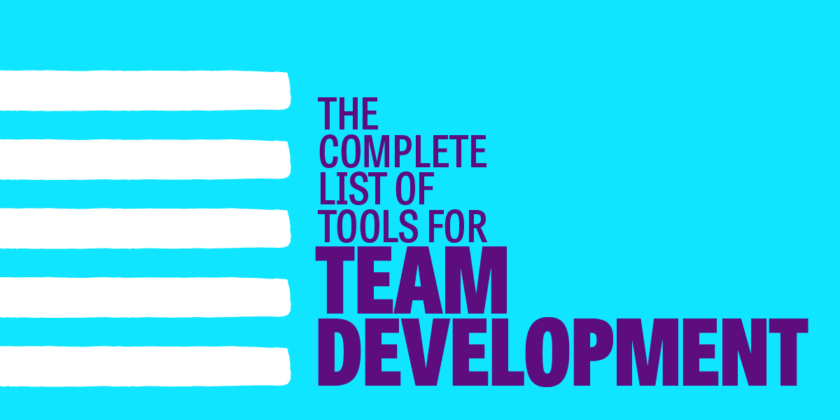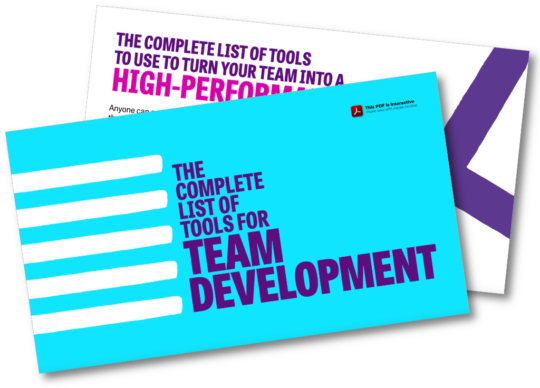The complete list of tools to use to turn your team into a high-performance unit
Anyone can put a team together, right? Pick a few talented individuals, give them a mission to complete and bam, you’ve got yourself a team! Actually… Not quite.
Good teams are more than just a collection of people. Their members put the team’s performance above their own and work together towards a clearly defined goal as a collaborative unit. This kind of magic doesn’t just happen overnight, and every person in the team has a role to play to make it happen. Reaching the stage where people are engaged, motivated and working effectively requires effort and sometimes, a little help from the organisation.
The perfect team development ratio
There are things you can do every day to make a difference and cultivate a climate of collaboration and trust within your team. Starting small with a few tools and exercises could actually help everyone get to know themselves and their colleagues better, and thus open the door to better dialogue and greater understanding of each other’s motivations. Sounds good? At Let’s Talk Talent, we thought so too. And because your team members are most likely a bunch of wonderfully varied people with different strengths, drivers and requirements, we strongly believe in a holistic approach.
We use a mix of science, arts and humanities to make sure we speak to people’s hearts and heads at the same time. So below is a selection of our favourite tools, from the scientific profiling to the softer communication exercises, to facilitate team development and help you foster a culture of trust, innovation and inclusivity that allows your people to bring their whole selves to work, every day.
Using science to improve team development
The science side of our three components is all about uncovering people’s strengths and drivers. In short, it looks to encourage individuals to truly get to know each other better and helps team leaders understand the hard skills that make up their teams. The scientific approach uses frameworks and rigor to assess individuals and determine how people prefer to work, which management style works best and what contribution each member can bring to both their team and the organisation.
These are probably the kind of tools you are more familiar with or have used before, such as:
- Psychometric tools (DISC profiles, Insights Discovery, and the Myer Briggs Type Indicator)
- Strengths’ assessment tools (Strengths Scope)
- Motivational profiling tools (Motivational Maps)
Profile assessments can also lead you to uncover blind spots within the makeup of your team. Mapping out everyone’s hard skills may highlight some gaps and give you a start point to determine what needs to be developed in each individual in order for them to be able to support the team better. Individual training plans can then be used to turn that knowledge into action and support staff’s professional progression, helping them reach their full potential.
For those of you who may be suffering from psychometrics fatigue, there are other innovative ways to encourage staff to get to know each other better. Ask each person to write a user manual about themselves to find out what really makes them tick. And don’t forget the social side. If you are bored of virtual happy hour or online quizzes, try some of these 33 team building exercises you can run remotely.
The art’s side of the team building equation
The art’s side of the equation really looks at generating employee engagement, as well as recognising the contribution they are bringing to the team and the wider organisation. Whether it is the idea of contributing to a cause important to them, such as creating innovative new products that positively impact people’s lives, the community that surrounds them when they are at work or the career opportunities at their disposal within the organisation, finding out what makes them come to work every day will ensure you know where to focus your motivation efforts.
Our top tools to create an engaged workforce are below:
- Patrick Lencioni’s 5 dysfunctions of a team looks at identifying and overcoming various dysfunctions and allows you to generate commitment and accountability, and overall achieve better results within the team unit. Buy 5 dysfunctions of a team book here.
- Zella King and Amanda Scott’s Personal Boardroom is all about identifying who is in your corner and investing time and effort to develop those particular relationships. It can guide individual team members looking for help, as well as teach them how to efficiently help others, generating collaboration and trust. Buy Personal Boardroom book here.
- Team stand ups are a fun, energetic way to get everyone talking and understanding each other’s role within a project. Get your team standing up (yes, even if doing stand ups virtually) and answering three little questions:
- Since the last stand up I have…
- Before the next stand up I will…
- What’s slowing me down is…
These will ensure your team feels more connected on a daily basis.
Day to day actions can also include regular recognition, from a simple ‘well done’ to more formal recognition initiatives each time a milestone is achieved. Brainstorming and ideation sessions can also be great tools to use to create a climate of teamwork and innovation. However, for this to happen, it is important for participants to trust that they can express their views, make suggestions and discuss ideas freely and safely.
If you need guidance on how to create an effective ideation session that fosters collaboration, try the Wall of Ideas exercise. Just remember to stock up on post-it notes first.
The last piece of the team development puzzle: the humanity
The last of the three parts in our holistic approach to team development speaks to the human skills needed to work together in a team. It involves communicating openly throughout the team development process and building empathy and trust gradually as you go along. These are not the kind of skills you build by attending a training session or conference. They are cultivated and developed through daily practice and activation. But if that’s the case, how can you support that side of your team’s development? There are indeed some tools available to use.
Our top tools to facilitate teamwork and communication:
- Defining your team’s purpose in 6 words or less. If you can’t do that right now, alignment will be hard to get from the rest of your team and your objective may need to be further defined.
- Team charters can also be used to ensure everyone is moving in the same direction and following the same ground rules. Have a look at https://www.designabetterbusiness.tools/tools/team-charter-canvas for tips on how to get started.
- Project kickoffs are a great way to ensure team buy-in from the very start of the project.
- Project retrospectives ensure you remain on track by setting milestones, reviewing them regularly, course-correcting along the way and celebrating success. They can also help you discover helpful habits and team processes that work well. For more guidance on how to run a retro visit here.
- Positive feedback is so important and is often overlooked. The Appreciation Train is a great way to get some energy going amongst your team and start the day the right way.
- Team Reflection is also useful to help staff express thoughts, views and feelings about a shared experience. Find out how to run one of those sessions here.
Conclusion: The best tools for team development
For a team to reach the performing stage takes time, effort and commitment from everyone involved. A culture of collaboration and trust does not happen under instruction, and it has to be nurtured and encouraged. But whilst everyone is accountable for the team’s dynamics, managers, team leaders and HR professionals can help set the stage and actively foster the right environment by making the rules of engagement clear.
And don’t forget that whatever stage your team is at, from forming to storming, norming and performing, team development tools can help you iron out kinks and get the best out of each person. A team away day can also be a great way to get your team development story going. However, check out our list of the 10 worst team building activities to avoid on your away days.
We hope you find our list of tools and frameworks useful. If you have your own to add to the list, feel free to share them, we’d love to hear from you.
Book a call with us to find out how to improve your overall team performance, or have a look at our team development services page for a ton of free resources!
Related team development resources:
- Team development and facilitation at Money Supermarket Group [Case study]
- The changing role of leaders in team development [Podcast]
- Book a facilitated away day for your team [Service page]
- Navigating the first stage of team development: Forming [Blog]
- Getting out of the storming phase of team development [Blog]
- Getting comfortably lost: How to move your team out of the norming phase [Blog]
- Reaching the performing stage of team development [Blog]
- How to run a kickass corporate away day [Blog]
- Team development consultancy services [Service page]
- 10 worst activities for team building events [Blog]

